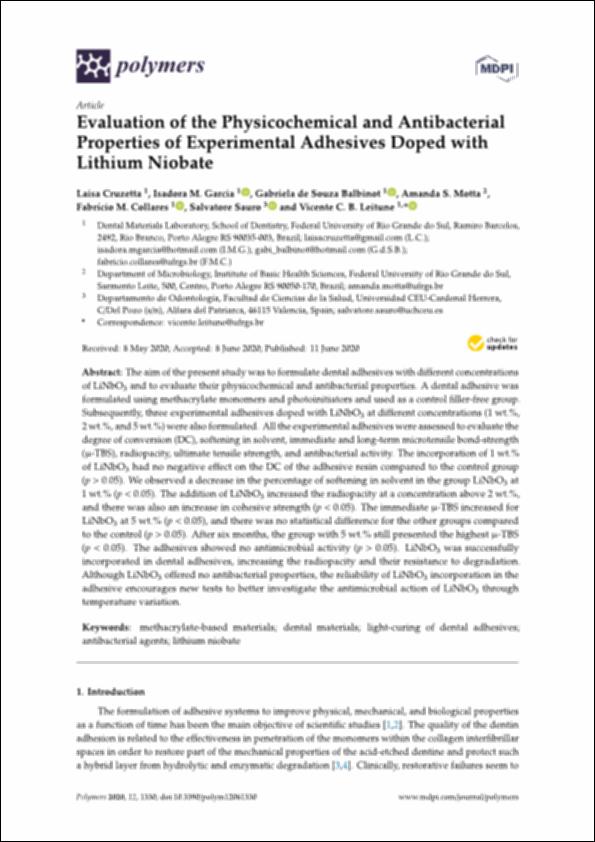Please use this identifier to cite or link to this item:
http://hdl.handle.net/10637/12566Evaluation of the physicochemical and antibacterial properties of experimental adhesives doped with Lithium Niobate
| Title: | Evaluation of the physicochemical and antibacterial properties of experimental adhesives doped with Lithium Niobate |
| Authors : | Cruzetta, Laisa Martini Garcia, Isadora Souza Balbinot, Gabriela de Motta, Amanda S. Collares, Fabrício M. Sauro, Salvatore. Branco Leitune, Vicente Castelo |
| Keywords: | Polymers in Dentistry.; Polímeros - Aplicaciones en Odontología.; Endodontics.; Endodoncia.; Lithium in Dentistry.; Dentistry, Operative.; Materiales dentales - Propiedades.; Dental materials - Properties.; Litio - Aplicaciones en Odontología.; Odontología restauradora. |
| Publisher: | MDPI |
| Citation: | Cruzetta, L., Garcia, I.M., de Souza Balbinot, G., Motta, A.S., Collares, F.M., Sauro, S. et al. (2020). Evaluation of the physicochemical and antibacterial properties of experimental adhesives doped with Lithium Niobate. Polymers, vol. 12, i. 6 (11 jun.), art. 1330. DOI: https://doi.org/10.3390/polym12061330 |
| Abstract: | The aim of the present study was to formulate dental adhesives with di erent concentrations of LiNbO3 and to evaluate their physicochemical and antibacterial properties. A dental adhesive was formulated using methacrylate monomers and photoinitiators and used as a control filler-free group. Subsequently, three experimental adhesives doped with LiNbO3 at di erent concentrations (1 wt.%, 2 wt.%, and 5 wt.%) were also formulated. All the experimental adhesives were assessed to evaluate the degree of conversion (DC), softening in solvent, immediate and long-term microtensile bond-strength ( -TBS), radiopacity, ultimate tensile strength, and antibacterial activity. The incorporation of 1 wt.% of LiNbO3 had no negative e ect on the DC of the adhesive resin compared to the control group (p > 0.05). We observed a decrease in the percentage of softening in solvent in the group LiNbO3 at 1 wt.% (p < 0.05). The addition of LiNbO3 increased the radiopacity at a concentration above 2 wt.%, and there was also an increase in cohesive strength (p < 0.05). The immediate -TBS increased for LiNbO3 at 5 wt.% (p < 0.05), and there was no statistical di erence for the other groups compared to the control (p > 0.05). After six months, the group with 5 wt.% still presented the highest -TBS (p < 0.05). The adhesives showed no antimicrobial activity (p > 0.05). LiNbO3 was successfully incorporated in dental adhesives, increasing the radiopacity and their resistance to degradation. Although LiNbO3 o ered no antibacterial properties, the reliability of LiNbO3 incorporation in the adhesive encourages new tests to better investigate the antimicrobial action of LiNbO3 through temperature variation. |
| Description: | Este artículo se encuentra disponible en la siguiente URL: https://www.mdpi.com/2073-4360/12/6/1330 Este artículo pertenece al número especial "Polymer-based materials in Dentistry". |
| URI: | http://hdl.handle.net/10637/12566 |
| Rights : | http://creativecommons.org/licenses/by/4.0/deed.es |
| ISSN: | 2073-4360 (Electrónico). |
| Issue Date: | 11-Jun-2020 |
| Center : | Universidad Cardenal Herrera-CEU |
| Appears in Collections: | Dpto. Odontología |
Items in DSpace are protected by copyright, with all rights reserved, unless otherwise indicated.


